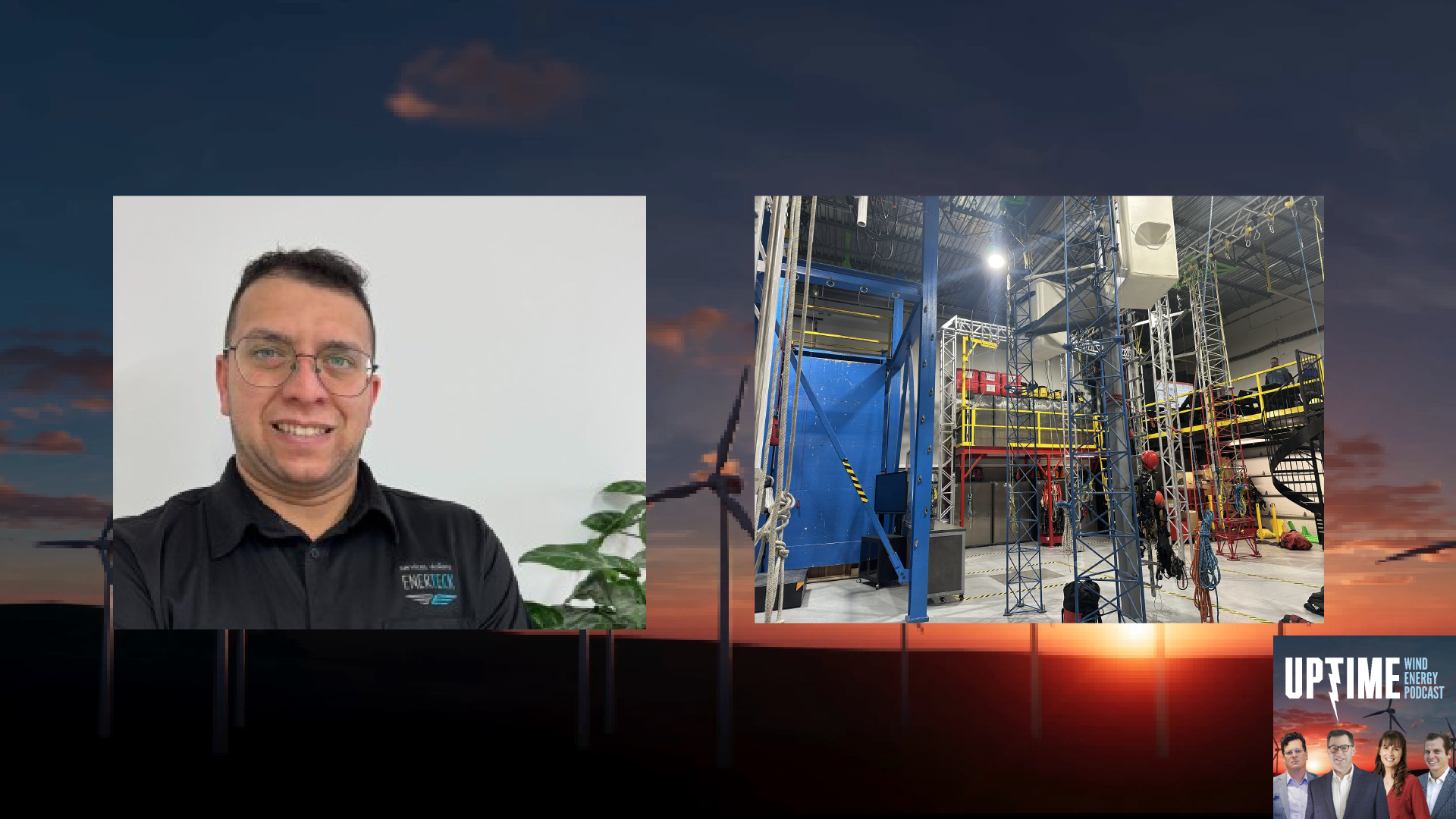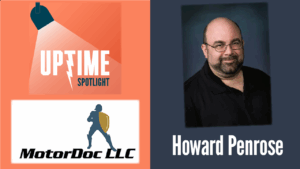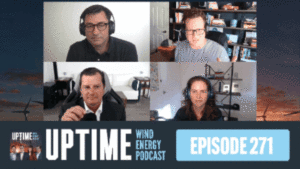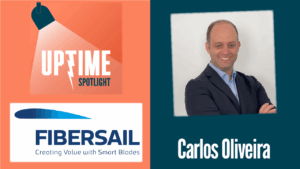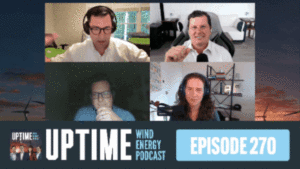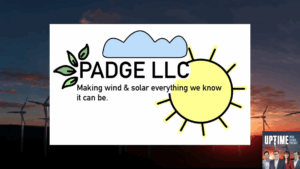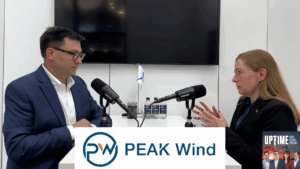Podcast: Play in new window | Download
Alex Fournier, Director of Composite Operations at Enertek, discusses the importance and training of SPRAT certification for wind turbine technicians. He details the certification levels, recent changes in safety standards, and the significance of proper protective gear and equipment maintenance in rope access and blade repair.
Sign up now for Uptime Tech News, our weekly email update on all things wind technology. This episode is sponsored by Weather Guard Lightning Tech. Learn more about Weather Guard’s StrikeTape Wind Turbine LPS retrofit. Follow the show on Facebook, YouTube, Twitter, LinkedIn and visit Weather Guard on the web. And subscribe to Rosemary Barnes’ YouTube channel here. Have a question we can answer on the show? Email us!
Allen Hall: With wind turbine scaling up and rope access becoming more critical. Technicians need proper training for safe and efficient blade repairs. This week we speak with Alex Fournier director of Composite Operations at Enertek, Alex brings insight on the spread certification process and how recent changes are enhancing safety.
Efficiency for technicians working at Height.
Speaker 2: Welcome to Uptime Spotlight, shining Light on Wind. Energy’s brightest innovators. This is the progress powering tomorrow.
Allen Hall: Alex, welcome to the program.
Alex Fournier: Thank you guys for having me once again.
Allen Hall: Yeah, we’re glad to have you back. There’s been so much so many changes that has happened since the last time you were here, but today we want to talk about SPRAT training and. What this means for the industry and what the latest and greatest is in terms of sprt.
And for those who don’t know what SPRT is, it’s actually an acronym like most things in Wind, it’s the Society of Professional Rope Access Technicians, and they create [00:01:00] the standards around. The knowledge you’re supposed to have and the skills you’re supposed to have if you want to climb with rope access.
Now. I, Alex, I wanna start off first, like how big of a problem do we have right now on the training on rope access technicians? I see a lot of variation across the United States in particular. Are you seeing the same thing, that they’re just not so much a concrete standard everybody’s using?
Alex Fournier: I think in Canada, like we don’t have that many schools that offer the course, first of all. So I think we don’t have much in the east Coast. We probably have what? Three, four. In the west coast they have a little bit more. And it’s often like vendors that will offer it. So it’s a mistress, for example, offered a course.
They do IDA and spread. I did my course at Novel in Montreal, which is one of the best training center I’ve seen in all my years of Rob Access. Celtic Falcon too in the East coast. Really good training center. But I [00:02:00] think since we don’t have that many, everyone is kinda like on the same page, so everyone talked to each other and the course is pretty well structured, at least in Canada.
Before when I started the course was four days, and then you had one days for the exam. So it’s a lot to learn in four days, but now they changed it to five days of course, and then one extra day for the exam. So that give you much time to train and, if you don’t understand something you can.
You can really take the time to really understand it. So you’re ready for the exam.
Joel Saxum: Alex, let me ask you a question about SPRAT and ia, right? ’cause Sprat is the North American version. IRATA is usually the EU version or rest of the world version. They are they’re organizations that push this safety forward and there’s, this is how we should do things.
And a lot of times a company will adopt it, say, X, Y, Z operator says, if you’re gonna be on ropes on my site, you must be sprat level, this level, that level, that, however. Correct me if I’m wrong here, but this is my take on it. They’re not actually like a [00:03:00] governmental association. They’re not an OSHA or something that mandates that you must have.
It’s just these things are in our industry, sprat best practices. This is what people live by. This is how we do it. Okay. That’s correct. Yeah. So can you walk us through the different levels of spray? ’cause I know there’s like a 1, 2, 3. What do those all mean?
Alex Fournier: Yeah. Level one basically you’re just a basic technician.
You just learn how to move yourself on the ropes basically. So you’ll do basic like rope Totaro transfer, or you’re gonna pass deviation. All the basic maneuver that you need to know on ropes. You’re gonna learn it into your level one which is great. Then to be a level one you just need to be 18-year-old and you can sign up and do your level one.
That’s the only requirement. Level two is after you did 600 hours on ropes and six months of experience as a level one. Then you can do your level two which you’ll learn more. It will be more like rescue scenario. So you’ll do some basic [00:04:00] maneuver combined with rescue, but yeah, so as a level two, you’re gonna learn more as taking some charge up and moving some charge up in the air.
And then to be a level three, it’s kinda the same thing you do you’re level two, so then 600 hours as a level two, and then six months as a level two, and then you can go to level three. And then level three, you do every basic maneuver that I said in level one, but it’s rescue, so you’re gonna do like a climbings rescue.
You’re gonna do deviation rescue, ballet rescue just rope to rope transfer with a victim on you. So it’s every maneuver with a rescue because when you’re a level tree, normally you’re in charge of the site or you’re gonna be in charge of. All the employees, not necessarily, but normally that’s all it is.
So you wanna make sure that you’re able to rescue pretty much everyone in every
Joel Saxum: scenario. So what is, okay, so we have level ones, level twos, level threes. What is a normal, and we’re talking blade repair here, [00:05:00] right? This is the Uptime podcast. So what is a normal blade repair, sprat rope access crew look like?
Alex Fournier: So I know a lot of people will be, mad, that’s what I’m gonna say. But normally when you work, we call it when the rope access world, the wind turbine industry is the easiest rope access world. Because you’re only doing you’re only going down. You’re only going up. There’s not much to it. You’re not gonna do crazy deviation or you’re not gonna do crazy, like zip line and all that stuff. If you do oil and gas, it’s much bigger. But in rope access, in the wind industry, normally a level one and level two. It’s pretty much that a level three might be overkill sometimes. On big job you probably want to have one just ’cause you probably have more knowledge and project management.
But normally just a regular team, it’s
Joel Saxum: gonna be a level two and a level one. Yeah. And from my experience, basically everybody’s dropping down two, two people on the blade. You don’t go by yourself. So there’s always gonna be two [00:06:00] technicians on that blade. And that makes sense. What you’re saying is and while people may not like this of rope access, what it looks and that is a little bit easier because for the most part, you’re going up and down and. Two dimensions, right? It’s just up down on that one thing. Whereas in, I’ve been on, I’ve been offshore on oil and gas crews where you see people in three dimensions, guys going across tanks and all kinds of crazy stuff in between.
Pylons, like that’s pretty, that’s some pretty advanced stuff. And when you watch those guys work, it is really impressive. Sometimes the really experienced ones, I’m sure they are level threes or whatever, how they can zip around. It’s the same thing on a wind turbine though. When you’re, if you’ve never seen that and you watch these people,
Alex Fournier: it’s
Joel Saxum: mind blowing.
Alex Fournier: It’s really the industrial athletes, that’s how we call it normally.
Joel Saxum: But it’s really impressive. The seasonality of wind makes that kind of stuff difficult because what happens is from a lot of times, okay, we’ll take North America for example, because of our blade repair season. You may be, if you’re a rope person, you may be out on ropes from April till September, [00:07:00] October, depending on how far north you are.
And then you got three, four months off. So coming back around to April again, much. A little bit tough, isn’t it, when you’re coming off the couch.
Alex Fournier: Yeah. And I gotta see a lot of people they take it off in the winter and I don’t blame them ’cause it’s really cold when you do ropes. But when you come back, you in that if you are of bench board in six months, you shall do a day at a training center to just put you back in your element.
So yeah, you shall still practice a little bit. But yeah, coming back after two months of holidays or three months of. Vacation. It can be hard. Yeah, you’re gonna be sore. Definitely. The first you’re gonna be sore.
Allen Hall: Let me ask the obvious question, because a lot of guys that do wind turbine work in the summertime do something else in, in the fall and the winter, but they want to stay on ropes.
So is then the sprat carries over. So even if you’re just doing spprt work for a wind turbine, you can get over into oil and gas and do some rope work there, or. Wherever the place is. So it’s so itpr as a [00:08:00] universal training system in a sense. It’s not just wind specific.
Alex Fournier: Yeah. It’s basically, it’s kinda like a driver license.
And the wind turbine industry is kinda like the car. So let’s say you go to oil and gas you have your driver license, your rope access guy. But the car is, let’s say like the oil and gas industry, like myself, I started in 2015 as a ax technician. I started doing window cleaning in Montreal.
So I was washing windows and then one of my friend got me into the wind industry. But definitely around the spread universe. You can do building maintenance. You can do oil and gas, you can go and mines, you can go in wind turbines. So there’s a lot of universe that are related to the spread industry as well
Joel Saxum: as Ida.
So staying up to date on it. What kind of changes have you seen lately in the for the Spprt certification? What does it look like?
Alex Fournier: So for spprt, one of the big change that will be related to the wind industry is that you don’t need A level three on site anymore. So I know a lot of [00:09:00] people ’cause you cannot have a level trees on every wind turbine of your project.
So Sprat said, as long as your level two just do up and down maneuver. So you cannot do like crazy ballets and zip line and all that stuff, but we basically just do up and down, right? So as long as you do up and down maneuver and your level two is trained you can have only a level two taking care of the job.
Allen Hall: So to get to that point of being a level two, if you’re just starting in the industry, takes several months to get there. How, what’s the best way to go about doing that?
Alex Fournier: If you’re really new let’s say it’s your first time, like doing something related to wind industry and you’re a level one and you’re just starting sprats say that 600 hours and six months as a level one to be level two you need to know it’s 600 hours on ropes.
You cannot be just chilling in the wind. Turbine doesn’t count as being on ropes. You actually need to be on ropes or calling ropes or putting ropes in a bag. Doesn’t count as hours. So you need [00:10:00] to be 600 hours on ropes in six months as a level one. I will say if you’re able to do 600 hours in one season, in six months, that’s really good.
You can do your level two obviously will give you more seniority. Like you’re gonna be a level two so you can tap your shoulder. But I will say if you’re really new, maybe I will do another year as a level two, not as a supervisor, but just, to understand like all the industry work and, slowly taking the role as a level two.
But that will be my approach. Let’s say you get your ticket and then you do one season as just a level two, and then. Once you’re ready, you go As a lead, that will be all. I will do it. That’s how I did it. But if, of course, if you’re ready, you think after your 600 hours go ahead and do it.
But that’s how I see it.
Joel Saxum: We’re talking blade repair too, right? So rope this is why blade repairs like. So complicated because we’re just talking about the rope access part of it, right? We’re just talking about how you get to work. Yeah. We didn’t talk about Blade yet.
Yeah. Your [00:11:00] co your commute is the, probably one of the craziest commutes in the world to get to the actual job task. But now we’re, then you gotta get there, then you gotta, yeah. Then you gotta learn blade repair. So I think that if you’re a sprat level one, basically you’re a minimum of a season sprat, level two, you’re probably two seasons.
Then level three, maybe at the beginning of that fourth year, you’re taking, you’re level three and you’re ready to run a crew. Does that look about right?
Alex Fournier: Yeah, it look about right for myself, I did two years as a level one one year as a level two, and then I did my level three, like really fast.
But I was ready to do it. But yeah, ’cause like you said, you also need to learn how to do fiberglass also, right? So you gotta learn how to be confident on ropes and how to manage all your rope, all your stuff, like all your buckets on you, all the elements around you. And then you need to do the fabricas as well.
So if you’re learning everything at the same time, it can be a little bit overwhelming. But just take your time and you’ll do just fine.
Joel Saxum: Alex, I’m gonna ask you a question. [00:12:00] And this is a non access guy. How do you use the restroom when you’re hanging on ropes?
Alex Fournier: There’s different school of thought.
You need to know that ammonia, like we have a ammonia in our bodies, but it’s one of them. The bows, dangerous material for RNS, it’s ammonia, like it will just destroy your R ns. So you need to be really careful of what you do when you go to the bathroom. I will recommend removing your RNS before you do so it’s either you go down or you can take the risk to do it up there. I already did it up there. It’s not super fancy, but you can do it.
Allen Hall: See, that leads into my question about taking care of your equipment. Spprt walks you through how to maintain your gear, right? What are some of the keys to keeping your equipment ready to
Alex Fournier: climb?
So basically, as a level one, you should even all the levels, you should do like checkup every day before you. Climb the tower or what you’re about. The job you’re about to do is you check the webbing, you check your RNS if it look good you check if there’s any discoloration, if you see some stitches going away, or if you see that it start to rip, obviously you need to [00:13:00] discard.
Same thing with plastic or metal. If you see cracks, if see your plastic discoloring or cracks in your plastic are your battle, you need to discard as well. But yeah just make sure that everything looks right and there’s no cracks or discoloration.
Allen Hall: So let’s talk about the, probably the, one of the most controversial topics when we talk climbing and ropes is helmets and all the protective gear, because everyone has their own opinion that everybody likes a certain style, and if they choose the other brand, it’s like, it’s not any good.
I wanna hear someone that I trust. Alex, you, what your thoughts are on some of the protective gear that you should be wearing when you’re climbing and using ropes.
Alex Fournier: I use the pencil lme, the vertex best. I’ve been using it since forever. I never change lme. I know there’s cask and pedal Petzel.
I rather petzel. For a couple of years I think Petzel, they were playing with their design and there was some stuff that, you had to buy clips to [00:14:00] fit on your helmet to be able to put a visor and the protective earrings. But now I think the, it all came together and their helmet is better today.
Like you can wear a lamp with a visor and then you can have your protective earring on your helmet. But yeah, it’s a must to have your ed lamps at least a visor, right? Like the visor and the protective earrings. ’cause when you do grindings. Wanna protect your hair,
Allen Hall: right? So all the accessories matter there now.
So the hearing protection is probably in the eye protection are the two big ones, and now they’re incorporated into the helmet themselves or clip on things now. So is there certain things about those that you should pay attention to? Maybe. Where, like the hearing protection, I always think the hearing protection is very person centric.
Like some hearing protection is comfortable, some of it is not. It’s really a decision of the technician. Have you seen a lot of variation there? Have you tried a bunch of things? What works for you?
Alex Fournier: What, for sure me, it’s really like the overhear like airing protective system and then the visor for me I wear glasses, right?
So if I wanna make sure that [00:15:00] I’m fully protected, I wear the visor. My glasses too. But yeah I wear both. I like to have shades, so I take the shade visor. So yeah, I take the shade visor. My overall like air protective. ’cause sometimes when you put like just the one in your hair little plugs, they wear out and you cannot use them.
You cannot use them like often. You can use them often, but you cannot, you’re not supposed to reuse a plug. So then like buying plugs, every day or just putting new plugs every day. Then you’re gonna lose them as when you have them on your helmet, you’re never gonna lose them.
Joel Saxum: I like the visor on the petzel too. ’cause it makes you look like a fighter pilot. Yeah.
Alex Fournier: With the air protective too. You really look like a jet pilot. But when you have everything on your lme, you’re not gonna forget it, because everything’s on it.
Joel Saxum: That’s the benefit, right?
’cause when you’re climbing, everything needs to be, you gotta, the stop the drop. We, the whole industry talks about that, right? So everything has to be carabiner off and lanyard it off and all this stuff. So if all of those things that you [00:16:00] use are connected to your helmet, boom, that’s one much easier way to go about your day.
’cause you just, soon as you clip that thing under your chin you got all your stuff on.
Allen Hall: Same thing for work gloves. What are you using?
Alex Fournier: Work gloves. The petzel once again.
Allen Hall: Really? Are you using petzel
Alex Fournier: for that? Okay. Yeah. The work gloves when I do propex is maneuver. I use my pencil gloves.
But when I do grindings, I use my cut resistant gloves. So I like the cut resistant clip from Grainer. I think they have some, and then the anti vibration too. When you grind for long hours, it, you know it’s gonna hurt your hands. So anti-vibration and anti cut, it’s the best.
Allen Hall: Okay, so I wanna talk about that now.
It was leading to this question, the anti vibration discussion. So over in Europe, they have limitations on how long you can operate a piece of equipment like a grinder because of the vibration and what it does to your hands and your arms, and. North America. I don’t think there are any regulations about that.
Are there regulations about that in Canada?
Alex Fournier: Not that I know of. Not that I [00:17:00] heard of. Maybe there is, but I’m not really sure.
Allen Hall: Yeah. I, from what I’ve seen in Canada, it doesn’t seem like there is. So essentially you could be using a grinder 4, 6, 8 hours a day. Gloves matter there. So what is the best in terms of anti vibration gloves?
I’ve seen a couple of ’em. They look really cool.
Alex Fournier: If you go on Uline and you wrote anti vibration gloves, they’re gonna be gray with a big Uline on it. And that’s the one that I use. And they’re pretty good. We use them for years and they really make a difference actually.
Allen Hall: Okay. All right. Yeah, because that it is a big issue over in Europe that they’re actually limiting people.
That, that’s fascinating. Alright, there’s a lot to do with Spprt and if you’re a technician, especially, you want to get into the wind industry and now’s the time to get into the wind industry, you’re going to need spprt training and you need to get to, at least to a level two. And that’s gonna take a bit of time.
So you need to get started now and find the right place. Now. Alex has a second job. Besides being an expert climber and doing blade repair, you’re the [00:18:00] director of composite operations at. Intertech is always looking for people, I assume, because that’s the big demand. When you make a call out for people to take a look at Intertech and join as composite technicians.
Alex Fournier: Yes. So if you’re a composite technician if you don’t have your rope access ticket, it’s okay. We’ll give it to you if you’re, a spread technician and you’re looking for a change of care and you want to try the win industry, we’ll take you as well. So if you do composite or rope access, we’ll take you both.
Allen Hall: Okay. And so how do they reach Intertech? How do they get ahold of you to get started,
Alex Fournier: On LinkedIn, you can send my message on my personal profile or on the Win Intertech page, or you can reach me by email.
Allen Hall: Obviously you can find Alex on LinkedIn and because he’s available and you see him posting and yeah, he’s an easy guy.
Get ahold of. So if you’re interested in being a wind technician, get started. Listen to the device of Alex that brought here today. Get your sprt training. Check out intertech, for sure. Great company. [00:19:00] Alex, thank you so much for being on the podcast. I love having you on.
Alex Fournier: Thank you guys. I love to be on the podcast as well.
It’s awesome every time.



